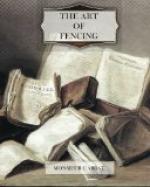The double Feint is in two motions, so that in order to push within the Sword, you must be without; and making a little motion in Quart within, with a little beat of the Foot, you feint again without closing the measure, keeping back the Body in order to be out of the adversary’s reach: if he parrys with his Fort, you must cut under in Seconde, and if he parrys with his Feeble, disengage to Quart within.
As there are in this Thrust three motions of the Sword, viz. the two Feints and the Thrust; the Foot must make as many, in order to answer the motions of the Hand.
Some Masters teach to make the double Feint without stirring the Foot; and others teach to advance on the first Motion. In the first Case, being in the Adversary’s Measure, you lose too much Time, which is very dangerous: And advancing on the first motion, is almost as dangerous as keeping the Foot firm, by putting yourself within the Adversary’s Reach; besides the Manner is not so graceful as that which I recommend, in which you are not within his Reach ’till the second Motion; and this is attended with another Advantage; for by bearing with the Right-foot, the Body must of necessity be kept back, and consequently, farther from the Sword of the Adversary, and in a better Condition to act.
There are two other Ways of making these Thrusts: The one by an Interval between the first and second Motions, joining or uniting the other two; and the latter between the second and third Motions, joining the two first. Though both these Methods are good, I prefer the latter, which puts you in a better Condition, not only to avoid your Adversary’s Thrust, but also to chuse your own; the Interval giving you a favourable Opportunity of doing both.
There has been so much said of the Feints which I have described, with their Opposites, that I shall say no more of them, nor will I speak of an infinite Number of other Feints, strait, single, and double, within, without, and under, in disengaging, or cutting over the Point, or under the Wrist, in risposting, or redoubling Thrusts; all which, depend on the three which I have described; in which, as in all Thrusts, the Body must be kept back, and the Fort of the Sword before you; by which Means, you are more out of Danger, and the Wrist is better prepared. Some Men mark Feints with the Head and Body, which is a very disagreeable Sight, and dangerous with Regard to Time.
A Feint is the Likeness of the Beginning of a Thrust: It is made to put the Adversary off his Guard, and to gain an Opening. In order to take Advantage of the Time and Light which you get by your Feint, you must take care to avoid an Inconveniency into which many People fall, by uncovering themselves in endeavouring to uncover the Adversary.
CHAP. XIV.
Of cutting over the Point of the Sword.




